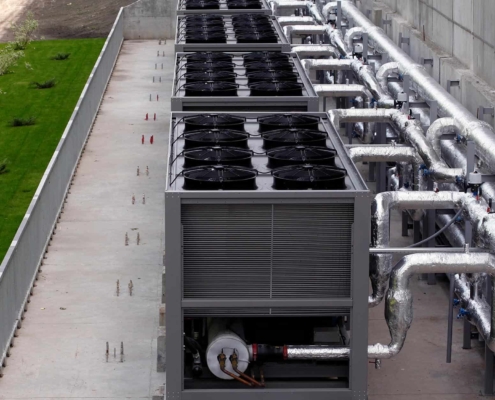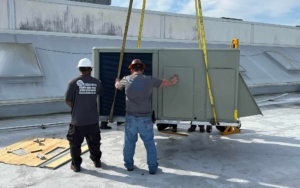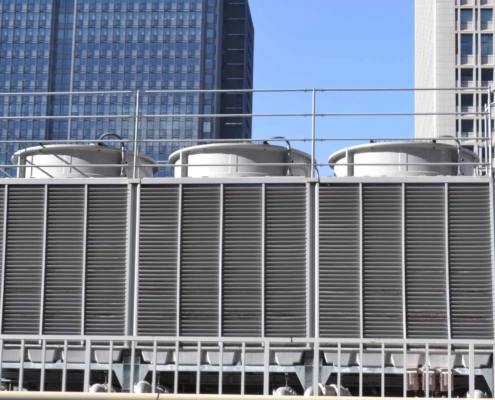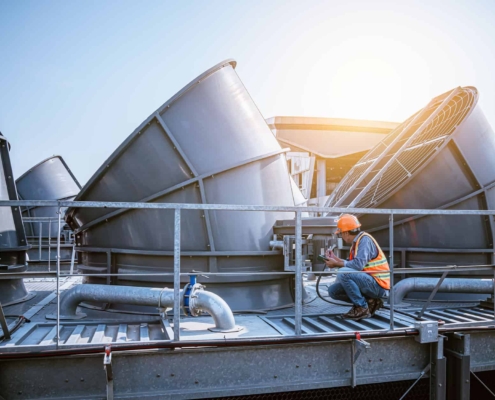 https://www.issmechanical.com/wp-content/uploads/2024/07/Chilers-system-for-data-center.jpg
1250
2000
Abstrakt Marketing
/wp-content/uploads/2024/04/svgexport-3-3.svg
Abstrakt Marketing2023-12-27 15:57:352025-07-03 11:27:37Data Center Cooling Strategies
https://www.issmechanical.com/wp-content/uploads/2024/07/Chilers-system-for-data-center.jpg
1250
2000
Abstrakt Marketing
/wp-content/uploads/2024/04/svgexport-3-3.svg
Abstrakt Marketing2023-12-27 15:57:352025-07-03 11:27:37Data Center Cooling StrategiesHow to Calculate ROI on a New HVAC System
HVAC (heating, ventilation, and air conditioning) systems play an integral part in our lives. However, they can also be significant investments, which is why understanding the potential return on investment (ROI) of a new HVAC system is essential.
We’ll explain the technical aspects in the simplest terms possible, using real-world examples to illustrate the concepts more clearly.
Understanding ROI and Its Importance in HVAC Systems
HVAC (heating, ventilation, and air conditioning) systems are critical investments for businesses. With rising energy costs, it’s important to understand the ROI of upgrades or replacements to maximize savings.
Calculating the ROI provides a clear picture of potential cost savings and the payback period. It simplifies decision making, prioritizing investments with the best returns, and ultimately indicates whether an upgrade will be financially beneficial long-term.
Definition of ROI
ROI measures the gain or loss from an investment relative to the amount invested. It’s calculated by dividing net profit by the total cost of investment. For HVAC systems, it helps compare energy savings versus the costs of a new system or service. A positive ROI means the investment’s gains exceed its costs over time. ROI is expressed as a percentage or ratio, indicating the efficiency of invested capital in generating returns.
How ROI Influences HVAC Investments
ROI directly impacts choices for HVAC equipment, replacements, and upgrades. A positive ROI percentage means an investment will pay for itself and provide ongoing savings. A higher ROI is desirable, maximizing cost recuperation and energy efficiency. A negative or low percentage means lower savings relative to investment costs.
The Importance of Calculating ROI
Calculating ROI provides a detailed understanding of the potential cost savings from HVAC investments and long-term energy efficiency. Knowing the ROI helps you set realistic expectations about cost recuperation timelines and payback on investment. ROI calculations factor in all costs, including equipment, labor, and maintenance. This helps you make informed purchase decisions.
Steps to Calculate ROI for Energy-Efficient AC
Analyzing Current Energy Consumption
First, collect data on current HVAC energy use. Review utility bills to determine annual costs and evaluate what areas of your building need the most heating and cooling. Consider the age and efficiency rating of your current system. Older, less efficient systems usually have higher energy costs. Understanding current consumption provides a baseline to predict savings with a new system.
Predicting Energy Savings With a New HVAC System
Next, estimate potential energy savings a new HVAC system may provide. Newer systems often have higher efficiency ratings, using less energy. Consult with HVAC contractors to calculate efficiency improvements and cost reductions. This gives the estimated annual savings you can expect from reduced energy consumption after installing the new system.
Understanding the Cost of a New HVAC System
Determine the total investment required for the new HVAC equipment, labor, and additional costs like permits or ductwork. Get multiple quotes from contractors outlining total costs. This provides the investment needed to calculate ROI based on the predicted energy savings.
Need help calculating ROI for a new HVAC system? Reach out to the experts at ISS Mechanical today.
Examples for Calculating Savings
Calculating the return on investment for a new HVAC system means analyzing both the upfront costs and the long-term savings. Here are some examples to help you evaluate the ROI for commercial HVAC upgrades or replacements:
Commercial HVAC ROI Calculation
For a small office building with 10,000 square feet, replacing an outdated HVAC system can cost $50,000 upfront. However, the new system is estimated to save $500 per month in energy costs due to increased efficiency. The ROI formula is:
ROI = (Gain from Investment – Cost of Investment) / Cost of Investment
With the numbers in this example:
- Gain from Investment = Energy savings of $500 per month x 12 months = $6,000 per year
- Cost of Investment = $50,000
- ROI = ($6,000 – $50,000) / $50,000 = –0.88 = –88%
In this case, the ROI is negative the first year. But as the energy savings compound over several years, the ROI becomes positive. After five years, the gain from the investment is $30,000 and the ROI is ($30,000 – $50,000) / $50,000 = –0.40 = –40%. At around eight years, the ROI turns positive.
Long-Term ROI for HVAC Systems
When calculating long-term ROI for an HVAC investment, consider these factors:
- Expected lifespan of the new system (often 15 to 20 years)
- Projected annual energy savings based on efficiency gains
- Estimated maintenance and repair costs each year
- Future energy cost increases (often 3–5% annual increase)
- Discount rate to account for the time value
For example, replacing a system that costs $10,000 now but saves $300 per year in energy and has a 20-year lifespan can be evaluated for ROI with a present value calculation:
- Gain from Investment (Present Value) = $300 annual savings x 15 years x present value factor of 11.47 (at a 5% discount rate) = $34,410
- ROI = ($34,410 – $10,000) / $10,000 = 2.44 = 244%
This yields a substantially positive ROI over 15 years once the future value of energy savings is properly accounted for.
How Much Energy Can Efficient HVAC Save?
Impact of Geography and Climate
The climate zone and seasonal weather variations can significantly impact ROI. For example:
- In hot southern regions, the energy savings from a new, efficient air conditioner will be higher than in more temperate northern areas.
- Buildings in cold winter climates will benefit more from a new furnace or heat pump than ones in mild locations.
- Hotter climates like Florida will have a different ROI profile than colder ones like Minnesota.
When evaluating ROI, be sure to select equipment optimized for local weather and location factors.
The Impact of Regular Maintenance on ROI for New HVAC
Ongoing maintenance is key to achieving the projected ROI from an HVAC investment. Lack of maintenance diminishes energy efficiency and leads to costly repairs. Recommended maintenance includes:
- Annual professional tune-ups and filter changes
- Periodic refrigerant recharging if low
- Checking and sealing ductwork for air leaks
- Cleaning coils and drains to prevent mold and drainage issues
- Checking belts, motors, and fans for wear and tear
Investing in scheduled maintenance optimizes efficiency and minimizes expensive HVAC breakdowns.
How Performance Affects Overall ROI for New HVAC
A poorly performing HVAC system will never achieve the expected ROI. Some factors impacting performance include:
- Undersized or oversized equipment for the building
- Improperly designed and installed ductwork
- Low refrigerant charge that reduces heat transfer
- Lack of zoning that leads to uneven heating or cooling
- Excess humidity that reduces comfort and efficiency
Having a contractor correctly size and install the HVAC system is essential to maximizing the return on investment.

Mistakes to Avoid When Calculating the ROI on a New HVAC System
Investing in a new HVAC system is a major expense for any business owner. While upgrading your building’s heating, ventilation and air conditioning can provide long-term savings, it’s important to accurately calculate ROI before moving forward.
However, there are several common mistakes businesses make when estimating the ROI of an HVAC system. Being aware of these errors can help you make a more informed decision about installing new equipment in your building.
Overlooking Additional Expenses
The upfront cost of the new HVAC unit is just one part of the total investment. Additional expenses like labor, ductwork modifications, wiring, permits, and disposal of the old system can add thousands of dollars to the overall price tag.
Get an itemized estimate from an HVAC contractor outlining all anticipated costs. Unexpected fees down the road can significantly reduce your return on investment.
Disregarding the Impact of Inflation
Most ROI calculations use today’s energy rates to project future cost savings from an efficient HVAC system. However, you need to account for the fact that electricity and fuel prices will rise over time.
Ask your utilities provider for historical data on annual price increases. Factor a conservative 2–4% annual inflation rate into your payback period calculations.
Forgetting to Factor in Future Costs
An HVAC unit’s life expectancy is approximately 15 to 20 years. So while that state-of-the-art system may seem super efficient now, you need to think about eventual repair and replacement costs down the road.
Add a budget for future HVAC maintenance and equipment replacement to get positive long-term ROI. This will provide a more realistic projection.
Avoiding common mistakes when calculating ROI will help you make the best decision for your business. Accurately estimating both the upfront expenses and ongoing costs over the system’s lifetime lets you determine whether upgrading your equipment is a smart investment.
With some careful analysis and advice from HVAC professionals, you can determine whether a new heating and cooling system makes sense for your building and budget.
Is AC a Good Investment for Your Business? ISS Mechanical Has the Answer
If you need help determining whether a new HVAC system is a smart investment for your business, contact the experts at ISS Mechanical today.
Related Postings
 https://www.issmechanical.com/wp-content/uploads/2024/07/Chilers-system-for-data-center.jpg
1250
2000
Abstrakt Marketing
/wp-content/uploads/2024/04/svgexport-3-3.svg
Abstrakt Marketing2023-12-27 15:57:352025-07-03 11:27:37Data Center Cooling Strategies
https://www.issmechanical.com/wp-content/uploads/2024/07/Chilers-system-for-data-center.jpg
1250
2000
Abstrakt Marketing
/wp-content/uploads/2024/04/svgexport-3-3.svg
Abstrakt Marketing2023-12-27 15:57:352025-07-03 11:27:37Data Center Cooling Strategies https://www.issmechanical.com/wp-content/uploads/2024/07/Commercial-HVAC-Troubleshooting-Reasons-an-AC-Is-Not-Cooling.jpg
1250
2000
Abstrakt Marketing
/wp-content/uploads/2024/04/svgexport-3-3.svg
Abstrakt Marketing2023-12-22 13:54:502025-07-03 11:27:38Commercial HVAC Troubleshooting: Reasons an AC Is Not Cooling
https://www.issmechanical.com/wp-content/uploads/2024/07/Commercial-HVAC-Troubleshooting-Reasons-an-AC-Is-Not-Cooling.jpg
1250
2000
Abstrakt Marketing
/wp-content/uploads/2024/04/svgexport-3-3.svg
Abstrakt Marketing2023-12-22 13:54:502025-07-03 11:27:38Commercial HVAC Troubleshooting: Reasons an AC Is Not Cooling https://www.issmechanical.com/wp-content/uploads/2024/07/How-to-Calculate-ROI-on-a-New-HVAC-System.jpg
1250
2000
Abstrakt Marketing
/wp-content/uploads/2024/04/svgexport-3-3.svg
Abstrakt Marketing2023-12-20 17:31:022025-07-03 11:27:38How to Calculate ROI on a New HVAC System
https://www.issmechanical.com/wp-content/uploads/2024/07/How-to-Calculate-ROI-on-a-New-HVAC-System.jpg
1250
2000
Abstrakt Marketing
/wp-content/uploads/2024/04/svgexport-3-3.svg
Abstrakt Marketing2023-12-20 17:31:022025-07-03 11:27:38How to Calculate ROI on a New HVAC System

